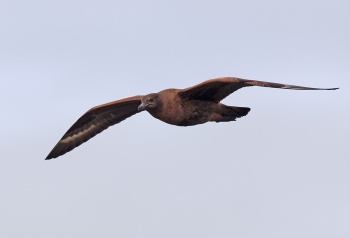Alternative name: Bonxie
- Stercorarius skua
Identification
Length 53-59 cm, wingspan 132-140 cm, weight 1.1-1.7 kg. A large and heavy skua.
Adult
- Overall dark brown
- Large white primary patches above and below (visible only in flight as wing flash))
- Powerful head and neck, heavy bill
- Fine cream-coloured streaks on nape, neck and mantle
- Broad central tail-feathers with rounded tips, not or only slightly projecting
- Soars more often than other skuas
1st year
- More uniformly brown with reddish tinge
- White primary patches less prominent
- Heavier body and more powerful flight than juvenile gulls
- No light cross-barring, heavier body and more powerful flight compared to juvenile Pomarine Skua
Similar species
The southern hemisphere Brown Skua is probably indistinguishable in the field, though is not currently known to overlap in range. The slightly smaller South Polar Skua migrates north into the Great Skua's range in the southern hemisphere winter (northern summer); light phase individuals are distinguishable by their paler body plumage, and dark phase birds may be distinguishable at close range by their less streaked and slightly greyer-toned plumage; plumage tone is however variable between individuals and some birds may be effectively indistinguishable.
Distribution
Breeds in Iceland, the Faroes, northern Scotland (common on the Shetland Islands), Norway (including Svalbard, Jan Mayen and Bear Island) and around Kola Peninsula in northwestern Russia.
Winters mainly off the coast of northern Spain and Portugal but also along the coast of Western Africa, in the Mediterranean, off the east coast of North America and south to Brazil.
Taxonomy
This is a Monotypic species.[1]
Has been placed in the genus Catharacta with the other large skuas (Sibley & Monroe, 1993; Clements, 2000). Formerly often considered conspecific with Brown Skua and Chilean Skua, and sometimes also with South Polar Skua. Genetic evidence suggests that the Pomarine Skua may be of ancient hybrid origin between Great Skua and one of the other smaller skuas.
Habitat
Open ocean, usually near coastlines.
Quite common on the Shetland Islands, living on moorland and hill tops. There are 400 breeding pairs on the Island of Noss, and this is one of the biggest populations in the world today.
Behaviour
Diet
A powerful marine predator and kleptoparasite, stealing food from other seabirds of all sizes, and regularly killing and eating other seabirds up to the size of Herring Gulls and occasionally even Great Black-backed Gulls and Northern Gannets (both significantly larger than itself); also takes fish and other seafood, including by following fishing boats for discards. On the breeding grounds it will also take land animals like Rabbits.
Breeding
The nest scrape may be lined with grass. The two large brownish-olive, blotchy eggs are laid at the end of May or beginning of June.
They are very protective of their nests and young, and they will attack intruders (including people) at any opportunity, flying from behind and kicking with their sharp claws.
References
- Clements, J. F., T. S. Schulenberg, M. J. Iliff, D. Roberson, T. A. Fredericks, B. L. Sullivan, and C. L. Wood. 2018. The eBird/Clements checklist of birds of the world: v2018. Downloaded from http://www.birds.cornell.edu/clementschecklist/download/
- Del Hoyo, J, A Elliot, and J Sargatal, eds. 1996. Handbook of the Birds of the World. Volume 3: Hoatzin to Auks. Barcelona: Lynx Edicions. ISBN 978-8487334207
- The Observer's Book of Birds' Eggs ISBN 0723200602
- Ellen Magnusdottir, Eliza H.K. Leat, Sophie Bourgeon, Hallvard Strøm, Aevar Petersen, Richard A. Phillips, Sveinn A. Hanssen, Jan O. Bustnes, Pall Hersteinsson & Robert W. Furness (2012) Wintering areas of Great Skuas Stercorarius skua breeding in Scotland, Iceland and Norway, Bird Study, 59:1, 1-9, DOI: 10.1080/00063657.2011.636798
- Furness, R.W., Boesman, P. & Garcia, E.F.J. (2018). Great Skua (Catharacta skua). In: del Hoyo, J., Elliott, A., Sargatal, J., Christie, D.A. & de Juana, E. (eds.). Handbook of the Birds of the World Alive. Lynx Edicions, Barcelona. (retrieved from https://www.hbw.com/node/53957 on 3 October 2018).
- Olsen, K. M. and Larsson, H. (1997) Skuas and Jaegers: A Guide to the Skuas and Jaegers of the World. Yale Univ. Press.
Recommended Citation
- BirdForum Opus contributors. (2024) Great Skua. In: BirdForum, the forum for wild birds and birding. Retrieved 25 April 2024 from https://www.birdforum.net/opus/Great_Skua
External Links
GSearch checked for 2020 platform.






